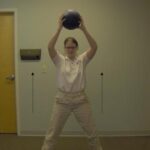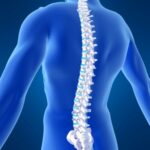Exercises designed to strengthen the lower back and abdominal muscles can assist in relieving back pain. Moreover, these same exercises can provide relief to the disk(s) by gentle separation of the vertebrae. Disks provide a cushion between the vertebrae in the spine. Nerves travel through small passageways within the vertebrae. When a disk has become swollen, the narrow passageways are sometimes pinched off causing that familiar back pain, leg pain, or tingling/numbness in the leg and/or foot. By performing these exercises, the vertebrae are gently separated and are held in that position by your back and abdominal muscles. Vertebral separation provides more space for the disk by removing some of the pressure. Continued pressure relief allows for greater blood flow, and allows the disk time to start the healing process. Once the disk(s) have started healing, and the swelling has started to go down, the symptoms of sciatica will begin to diminish.
Because your back is an important, and complex part of your body, your doctor should be consulted before you engage in any activity that could affect your back. This is especially true if your doctor has already prescribed pain treatment instructions, and/or a set of exercises for your sciatic pain.
3 Exercises for Back Pain / Sciatica Relief
You should wear roomy, comfortable clothes when performing these exercises. Remember, these are not calisthenics, and should be performed slowly, and deliberately, concentrating on the correctness of the exercise. Keeping your eyes closed will help to visualize the exercises as you perform them, and it will allow you maintain concentration. You should feel a gentle and enjoyable stretching of your muscles. If you feel pain, or strains, then stop immediately. Do not get discouraged if you cannot perform the exercise because of stiffness. In time, and with practice, you will master each one, and you will begin getting relief from your sciatic pain.
1. Using a mat or other form of padding, start by lying flat on your back. Position both of your hands, palms down, under the small of your back. Position your feet, soles down. Keeping your feet on the ground, draw them up towards your body as far as is comfortable. Make sure your butt stays firmly on the ground. Using your abdominal muscles, try to make the small of your back touch your hands. If your hands were already touching your back, then perform this with your hands at your sides. Try to hold this position for 10 seconds. Now, without changing your position, slowly raise your butt several inches off the ground. Tighten your abdominals in order to keep the small of your back pushed down. Hold this position for 10 seconds. As your muscles get stronger, this will get easier. Ultimately, try to perform the exercise for 2 minutes. Return to the starting position and relax. Relaxation time should be, at least, equal to the total time you spent doing the exercise.
2. If you have ever seen a cat stretching, you have seen this exercise in action. Start by getting on your hands and knees. Position yourself so that your back is flat, and your arms are extended slightly wider than shoulder width. Slowly stretch out by moving your hands forward, and away from you. Begin lifting your head so that it arches your back downward toward the floor. Keeping your abdominal muscles tight, continue the stretch until your stomach is touching the ground, and your head is leaning back as far as is comfortable. At this point, your lower body should be flat on the floor, and your upper body should be curved upward, chest out, head up, and supported by your arms. Hold this position for 10 seconds. Using your arms and shoulders, start pushing yourself back toward your starting position. At the same time, tighten your abdominals and start applying force on your knees to start lifting your lower body back to its starting position. Once your knees and lower body have reached the starting position, continue drawing your arms inward towards you. As you contract inward, start arching your back upward. Move your head downward, and roll your shoulders forward in order to fully arch your back upward. Hold this position for 10 seconds. Return to the starting position and relax.
3. This last exercise will probably be the most difficult, especially if you are stiff. Start by sitting on the floor with your back supported. Placing your back against the front of your couch is best, but a smooth wall will work fine. Sit with your knees spread out to the sides, and the bottoms of your feet touching each other, and drawn up as close to the body as comfortable. If you are limber, your knees should be touching/nearly touching the ground. If this is not the case, then use your hands to gently push your knees toward the ground. Go as far as is comfortable, and hold in that position, using your leg muscles. The amount of time and practice needed will depend on how stiff you are. Once you are able to sit with your knees touching/nearly touching the floor, along with the bottoms of your feet touching each other, you will be in the starting position, and ready to perform the exercise. Tighten your abdominal muscles, and slowly bend forward. Bend only at the waist. Your back will naturally start forming an arch as you continue forward, so try to keep your back as straight as possible. This will bring about a gentle stretching of the lower back. Move forward as far as possible using only your abdominal muscles, and bending only at the waist. Hold for 10 seconds; slowly return to the starting position and rest. As you become more limber, and your muscles become stronger, you will be able to bend farther and hold the position longer. Ultimately, your goal is to bend forward so that you can lay your forearms flat on the floor in front of your feet, with your hands clasping your feet.
Herbal Remedies for Back Pain / Sciatica Relief
In addition to the herbal remedies below, look for rubbing liniments containing oil of wintergreen and capsaicin. These oils, when rubbed into the skin, can aid in pain relief and stimulate circulation.
• Stinging Nettle has pain relieving and anti-inflammatory properties.
• Lecithin is a rich source of Choline and Inositol needed for healthy nerve function.
• St. Johnswort helps stimulate circulation and helps restore local nerve impulses.
• Ginkgo Biloba aids in restoring blood circulation, and aids in nerve function.
Performing these simple exercises on a regular basis can strengthen the muscles, provide compression relief for the disks in the lower back, and help relieve the symptoms of sciatica.



